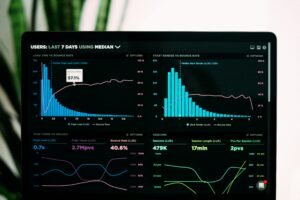Ever wonder how businesses turn mountains of data into smart decisions? It’s all about analytics and reporting! These two magical practices transform raw numbers into actionable insights and clear information. Ready to find out how this process works and why it’s a game-changer for companies everywhere? Stick around, and we’ll break down those intimidating buzzwords and show you how data can pave the way to brighter business decisions!
Understanding Analytics and Reporting
Data analytics involves examining raw data to discover patterns and trends. Think of it like being a detective searching for clues that reveal a bigger story. This helps businesses make wise decisions by turning numbers into clear, actionable insights.
Conversely, data reporting is like organizing a messy room by gathering data from various sources and presenting it in neat, easy-to-read formats like charts or tables. This makes it simple for everyone to understand what’s happening.
- Analytics converts data into insights.
- Reporting transforms data into information.
- Analytics is actionable.
- Reporting is informative.
- Both are crucial to a robust data strategy.
The key difference lies in their purpose. Analytics helps foresee future trends, while reporting shows current happenings. Imagine you’re a ship captain. Analytics is your telescope, helping you see ahead. Reporting is your map, showing your current location. Both are essential for navigating the sea of data.
Types of Analytics and Reporting Tools

Choosing the right tools for analytics and reporting is like picking the right gear for a hike. You need the right equipment to ensure a smooth and effective journey. Let’s explore some top tools that turn data into powerful insights.
1. Userpilot
Userpilot is a code-free growth platform that tracks user data and optimizes user experiences. Imagine owning a website and wanting to know how users interact with it. Userpilot collects this information and helps you make changes to improve the user’s journey. It’s like having a personal coach for your website, showing you what’s working and what needs fixing.
2. Databox
Databox is a cloud-based business analytics platform. Think of it as a dashboard for all your important metrics. It gathers data from various sources and puts it all on one screen, making it easy to generate reports and see key performance indicators (KPIs) in real-time. It’s like having a control center for your business operations.
3. Google Analytics
Google Analytics is ideal for measuring web traffic. It tracks metrics such as user sessions, new vs. returning visitors, bounce rate, and exit rate. Imagine you’re managing a theme park. Google Analytics tells you how many people visit, how often they return, and which rides they enjoy the most. This helps you make informed decisions to enhance the visitor experience.
| Tool | Key Features |
|---|---|
| Userpilot | Tracks user data, optimizes user experiences, code-free |
| Databox | Cloud-based, generates reports, views KPIs in real-time |
| Google Analytics | Measures web traffic, tracks user sessions, bounce rate |
Benefits of Using Analytics and Reporting

Analytics and reporting form the dynamic duo of the business world. They work together to turn raw data into actionable insights, making them vital for any business aiming to grow and succeed.
- Improved decision-making.
- Better organizational actions.
- Competitive edge.
- Enhanced understanding of operations.
- Informed decisions.
Enhanced data knowledge through analytics and reporting helps businesses make smarter decisions. When you know what’s happening in your company, you can act quickly and confidently. It’s like having a crystal ball showing you the best path forward.
A strong business intelligence strategy that includes both analytics and reporting can give you a serious competitive edge. Imagine knowing exactly what your competitors are doing and how to outsmart them. That’s the kind of advantage these tools provide, helping your business not just survive but thrive.
Step-by-Step Guide to Implementing Analytics and Reporting
Implementing analytics and reporting is like baking a cake. You need the right ingredients and must follow specific steps for the best results. Let’s break down the process of turning raw data into valuable insights.
- Define objectives.
- Collect relevant data.
- Choose appropriate tools.
- Analyze data to identify trends.
- Create reports to present findings.
- Implement corrective actions based on insights.
- Monitor and refine processes.
First, define your objectives. What do you want to achieve with your data analysis report? Clear goals help you stay focused. Next, collect relevant data from various sources—this is your raw material. Choosing the right tools is essential, much like picking the right kitchen appliances for your cake.
Analyzing your data is where the magic happens. Use your tools to dig into the data and identify trends. This step transforms raw data into actionable insights, like sifting flour to achieve smooth cake batter.
Create reports to present your findings, revealing facts, identifying risks, and monitoring business metrics. Implement corrective actions based on the insights gained. Keep an eye on your processes and refine them as needed. Just like checking your cake as it bakes, monitoring ensures everything stays on track for the perfect result.
Case Studies: Successful Implementations of Analytics and Reporting
Case studies are like the tech world’s success stories. They show real-life examples of how businesses use analytics and reporting to make smarter decisions and achieve great results. Let’s dive into some case studies that highlight the magic of these tools.
- Visier: Predicting future actions with random forest methodologies.
- Genesis Cloud: Quick transition from discovery to action.
- Custom dashboards: extensive use by Genesis Cloud customers.
These case studies show the transformative power of effective analytics and reporting. Take Visier, for example. Using random forest methodologies, they predict future actions based on past patterns, allowing companies to plan ahead and make proactive decisions.
Genesis Cloud helps users move quickly from discovery to action by providing easy access to necessary data. This means businesses can implement changes swiftly and efficiently, improving overall performance.
Lastly, the extensive use of custom dashboards by Genesis Cloud customers emphasizes the power of personalized analytics. Viewed millions of times per week, these dashboards provide invaluable insights that help businesses stay ahead.
Conclusion
Implementing analytics and reporting isn’t just a nice-to-have; it’s a game-changer. We’ve covered what analytics and reporting are, explored key tools like Userpilot and Google Analytics, and highlighted their benefits. From better decision-making to gaining a competitive edge, these tools are indispensable.
Real-life case studies show just how impactful proper analytics and reporting can be. Dive into the steps to get started, and you’ll find the insights invaluable.
FAQ
What is data analysis and reporting?
Data analysis and reporting involve examining raw data to identify trends and patterns, then organizing this data into understandable formats. This helps make informed decisions and present facts concisely.
What are the 3 main types of analytical reports?
The three main types of analytical reports are:
- Descriptive: Summarizes past data.
- Predictive: Uses data to forecast future events.
- Prescriptive: Provides recommendations based on data analysis.
Why are analytics and reporting important?
Analytics and reporting are crucial because they enhance data knowledge, helping businesses make better decisions, understand operations, and gain a competitive edge.
What is people analytics and reporting?
People analytics and reporting focus on analyzing employee data to improve HR decisions, optimize talent management, and enhance overall organizational performance.




